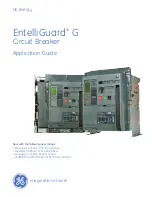
21
SECTION 14—Repair and Replacement
14.1—General
The following information covers in detail the proper method
of removing various parts of the breaker in order to make any
necessary repairs. This section includes only those repairs that
can be made at the installation site on parts of the breaker
that are most subject to damage.
Important: Upon completion of any kind of repair work, all
interrupter and mechanism adjustments must be checked.
Refer as needed to sections on mechanical and electrical
adjustments.
14.2—Replacement of Interrupter
Assemblies
Interrupters are supplied in complete interrupter assemblies
which include the vacuum interrupter mounted in the
interrupter support, the primary studs, and disconnect fingers.
CAUTION:
DO NOT ATTEMPT TO REMOVE OR REINSERT
THE VACUUM INTERRUPTER IN THE INTERRUPTER
SUPPORT ASSEMBLY. SPECIAL TOOLS AVAILABLE AT THE
FACTORY ARE REQUIRED.
1. Close the breaker and remove the coupling clamp, and
clamp screws(8, 9, Figure 6). Hold hex projection (6,
Figure 8) at the bottom of the operating rod insulator with
a 1 inch wrench and loosen the adjacent lock nut with a
3/4 inch wrench. Screw down the lock nut and the
operating rod insulator until clear of interrupter rod.
Remove the four bolts holding the pole assembly to the
mechanism and remove the old pole assembly.
2. Set the new pole assembly in place and install the four
mounting bolts. Set the pole assembly so that the
distance between the primary studs and the studs on the
adjacent pole is ten (10) inches center line to center line.
3. Screw the operating rod insulator up to mate with the
base of the interrupter rod. Install coupling clamp. Tighten
coupling clamp capscrews, then loosen them 1-2 turns.
a. With continuity indicator across the contacts, back off
the operating rod until the contacts separate,
(continuity indicator off).
b. Advance operating rod until contacts touch,
(continuity indicator on).
c. Advance operating rod two and one-half (2-1/2)
additional turns.
d. Tighten lock nut to 40-50 pounds/foot and the
coupling clamp capscrews to 8-10 pounds/foot.
e. Check contact wipe - must be 0.160 – 0.185 inch (set
all three phases before measuring). It is not
necessary that all three poles have the same wipe
measurement as long as all three poles fall within the
specified limits.
f. Check contact gap - must be 0.595 – 0.655 inch.
Adjust if needed per CONTACT GAP ADJUSTMENT
in MECHANICAL ADJUSTMENT section.
4. If a new interrupter assembly is installed, check and
adjust the wipe indicator (2, Figure 6) by bending the
reference arm (11, Figure 6) to line up with erosion disk.
5. Perform the VACUUM INTERRUPTER INTEGRITY TEST
as described in ELECTRICAL CHECKS section.
WARNING:
PRIMARY DISCONNECT WIPE CAN ONLY BE
CHECKED WHEN THE SWITCHGEAR IS DE-ENERGIZED.
14.3—Primary Disconnect Fingers
The primary disconnect finger assemblies can be removed
by removing two roll pins which hold them in place on the
primary studs. Finger contact surfaces should be coated with
0282A2048P009 lubricant.
14.4—Mechanism
Pin Retaining Rings - These rings are widely used in the
ML-20 mechanism to retain pins. They can be installed and
removed with a pair of standard pliers. Reuse is not
recommended. To remove, slowly squeeze the ears while
pulling. To install, position in the pin groove and squeeze the
installation ears closed leaving no more than 1/16 inch gap
between ears. Retaining rings can be obtained from your local
GE Sales Office by ordering part number 0282A2015G001.
14.5—Control Switches
Control switches may be removed from their mounting
brackets by disconnecting the wires and removing the
mounting hardware. When replacing the switches, check that
the correct type normally open or normally closed, is used.
Reinstall, wire, and adjust per DIMENSIONAL CHECKS -
CONTROL SWITCH ADJUSTMENT.
14.6—Trip Coil Replacement
TOOLS
REQUIRED
5/16”
Allen
wrench
Needle nose pliers
7/16”
Socket
wrench
7/16”
Box/combination
wrench
1/4”
Square drive ratchet
1/4”
Square 3” extension
Loctite #271 or equivalent
Содержание PowerVac
Страница 1: ...DEH 40368 Instructions g PowerVac Vacuum Circuit Breaker with ML 20 Mechanism ...
Страница 13: ...13 Figure 10 Control switches LCS Switch ...
Страница 26: ...26 Figure 14 Continued C Breaker closed spring discharged D Breaker closed spring charged ...
Страница 28: ...28 Figure 15 Continued Partial View A Partial View B Partial View C Partial View D Partial View D ...
Страница 29: ...29 Figure 16 Typical wiring diagram for ML 20 mechanism ...
Страница 31: ...31 Figure 19 Trip coil and linkage 1 Trip coil 2 Closing spring 3 Trip linkage adjusting rod and nut 3 1 2 ...
Страница 39: ...Intentionally Left Blank ...
















































